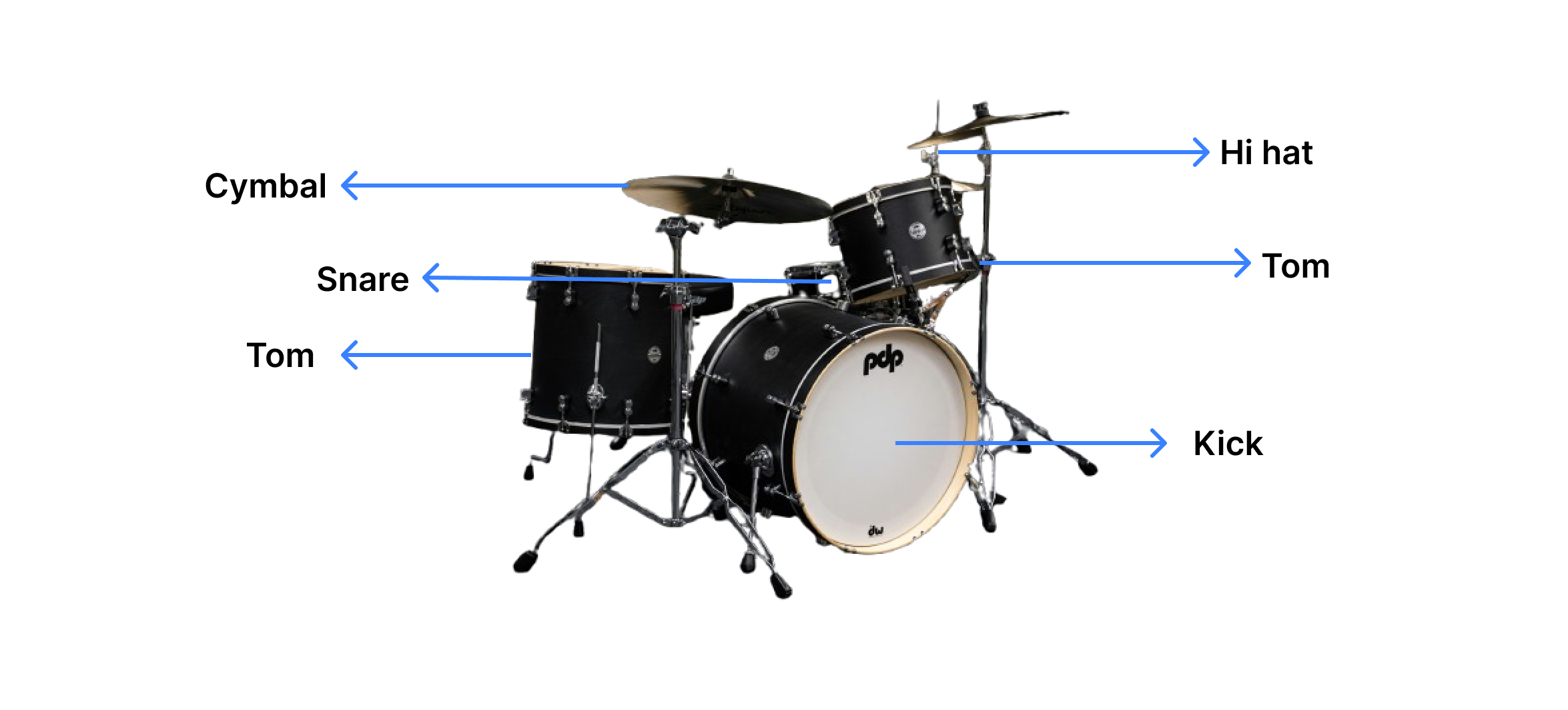Greetings, Flat community!
We're thrilled to share some exciting developments with you today. Responding directly to your valued feedback, we've expanded our high-quality instrument library with the addition of the Orchestral Drumset. Experience its rich sonic capabilities in this demo created by one of our amazing users:
Diving into drum set music notation can feel daunting, especially if you're new to drumming or composition. It's true, drums have a unique language when it comes to writing them down in music notation software. But here's the good news: you don't need to be a seasoned percussionist to get started. A solid grasp of the basics will set you on the right path to creating your own orchestral drum scores. And like anything musical, practice makes perfect. Let's explore the essentials and get you inspired to write your first orchestral drum piece.

Drum Set Components
The drum set, a powerhouse of percussion, is designed to be played by a single musician. The drummer's core role is to establish and maintain the rhythmic foundation for the entire band or ensemble. Drum sets come in various configurations, from simple setups to complex arrangements, each offering a unique sonic palette.
Here's a breakdown of the fundamental components:
- Kick Drum (Bass Drum):
- This large, low drum is typically played with a foot pedal. Its primary function is to provide the deep, driving pulse that anchors the rhythm.
- It is the low end of the drumset and often works along with the bass guitar.
- Snare Drum:
- Characterized by its sharp, crisp sound, the snare drum is crucial for defining the backbeat, often on beats 2 and 4 in a standard 4/4 time signature.
- It is used for fills, accents and rolls.
- Toms:
- These drums, available in various timbres (high, mid, and low), offer a range of tonal colors. They complement the kick and snare, adding melodic and rhythmic variety.
- They are heavily used in fills, and can be tuned to specific notes.
- Hi-Hat:
- Consisting of two cymbals mounted on a stand, the hi-hat can be played with a pedal or drumsticks.
- It provides a wide range of sounds, from tight, rhythmic patterns to open, shimmering textures. It also is used to keep the tempo.
- Cymbals:
- Cymbals offer a diverse array of sonic possibilities, adding color and texture to the drum set.
- Crash Cymbal: Used for impactful accents, often marking the beginning of musical phrases or sections.
- Ride Cymbal: A larger cymbal with a clear, sustained tone, often used for maintaining a consistent rhythmic pattern. It also has a "bell" portion that creates a sharp clear tone.
- Splash Cymbal: A small, high-pitched cymbal used for quick, bright accents.
- China Cymbal: Known for its trashy, aggressive sound, used for dramatic effects.
- Cymbals offer a diverse array of sonic possibilities, adding color and texture to the drum set.

Beyond these core elements, drummers can expand their setups with additional toms, cymbals, and auxiliary percussion instruments, allowing for endless creative possibilities.
Now, when we think of drums, our minds often jump to the classic drum set – the kick, snare, and cymbals driving a rock beat or jazz rhythm. But the orchestral world treats percussion with a different kind of reverence. It's not about a fixed setup, but a vast, colorful palette. While you might spot a snare or bass drum in an orchestral score, they're used with a level of nuance and precision that goes beyond simply keeping the tempo. Orchestral percussion is about texture, drama, and adding that perfect sonic accent to a piece, demanding a whole different level of versatility and tonal control from the musician.
5 Tips for Writing Effective Orchestral Drumset Parts
You might picture a drum set driving a rock anthem or a jazz groove, but percussion in an orchestra? That's a different world entirely. It's not about laying down a steady beat, but about adding subtle textures and dramatic flourishes. If you're up to to explore writing for orchestral percussion, these five tips will guide you in crafting parts that truly resonate.
- Listen to the Whole Score: Before you write anything, really listen to the entire piece. Understand the mood, the loud and quiet parts, and how the instruments talk to each other. This helps you know which instruments to add to your drumset and where percussion will sound best.
- Be Super Precise: Orchestral percussion needs to be very exact. Write down the rhythms carefully, use clear dynamics, and think about the small changes in rhythm that make the music interesting.
- Play with Sounds: Don't just stick to classic drumset, try different configurations from the instruments available in the orchestral drumset in Flat to create unique sounds that fit the music.
- Make it Blend: Remember, percussion is part of a team. Make sure your parts sound good with the rest of the orchestra and don't drown out other instruments.
- Think About the Players: Make sure the parts are easy to play. Is there enough space for all the instruments? Are the page turns in good spots? Thinking about these things makes it easier for the musicians.
💡 Extra tip: When composing with Flat, especially for beginners, a cheat sheet showing the placement of different elements on the staff can be very useful. Feel free to download the one we've created below.
To sum up, apply these simple tips to add orchestral excitement and depth to your drum music notation. Now, we invite you to explore the possibilities. Open Flat and compose an orchestral arrangement incorporating the Orchestral Drumset. If you're pleased with the outcome, please submit the link to your score to hello@flat.io for consideration in our community spotlight!

